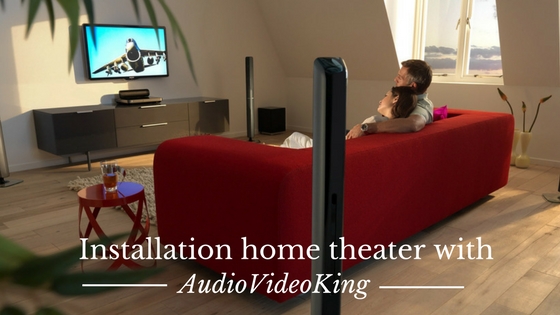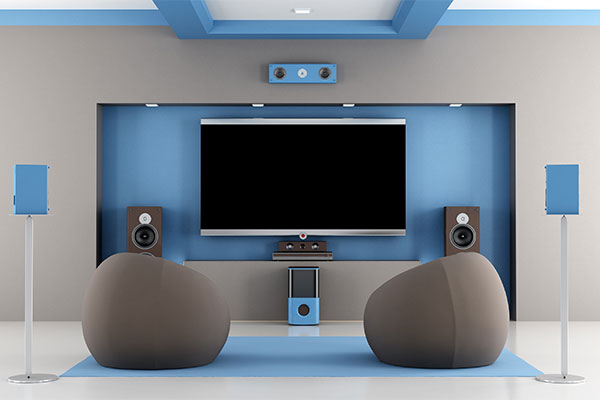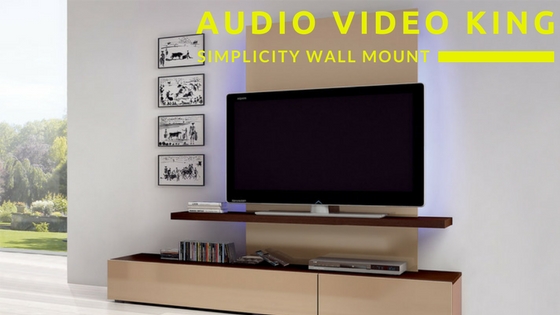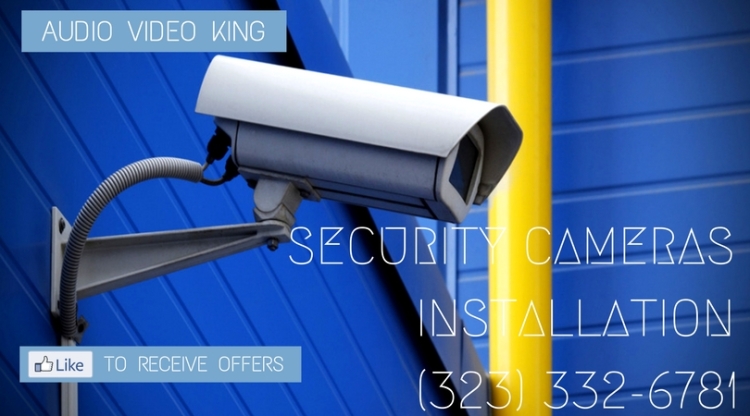 What do I have to pay attention to when installing a home cinema system? The question is often asked. We are already trying to get you started with a number of tips and points for attention.
What do I have to pay attention to when installing a home cinema system? The question is often asked. We are already trying to get you started with a number of tips and points for attention.
1. The room
The room in which the home cinema system is installed is sometimes forgotten as a factor in the home theater installation. Different aspects of a room have influence.
Let us first consider the image quality of your television. Light sources play a role: both natural and artificial light. The natural light during the day we can try to keep out with the right choice of curtains, of the dark type. However, we need a little light in the room, if only to find the remote control or to sip the glass. The low-wattage lights are best aimed at a corner or on a wall to provide indirect light. A low beam is even better: dimming when the film starts.
The shape of space also plays a role, and this in the auditive field:
- Rectangular space
This is the ideal shape for perfect placement of the speakers. Place the television against one of the short walls and your sofa in the middle of the room.
- Square space
Not so ideal. Unless this room is huge, the listening position will be pushed against the back wall by the shape of the room. Place the surround speakers against the back wall in the corners.
- L-shape
These spaces sometimes suffer from a strange bass sound. We advise you to think away the smaller space in the Land continue the installation as if it were a rectangular space.
The rear loudspeakers are best placed at an equal distance from the seat or sofa. They must also be placed slightly backward.
The included manual or built-in menu often gives you good visual support for placing the speakers. If you attach them to the wall or wall, you should aim them down a bit, towards the seat.
When you lay the cables, keep some cable left for the end. So you give the speakers some room to move when positioning. Do the same on the other side of the system. If your speakers are floor models, buy or make a support for the bottom. The center speaker gets a place on or under the television.
The last speaker you place is the subwoofer. This sound box provides the reproduction of the low tones such as explosions and other special effects. Here we can distinguish two types: passive and active. The latter needs its own power source, which means that this subwoofer has to be given a place close to an outlet.
Now that the wiring of the loudspeakers is ready, the fun part is coming: connecting the various devices. You can choose from different cables for which the quality differs considerably.
The cables that come with most speakers are of a lower quality and do not get the maximum out of your installation.
High-end AV cables are thicker (and more expensive) than normal cables but they have a much better response and less signal loss. They are especially recommended for slightly more expensive equipment.
Investing in a pair of decent cables often means a real transformation of your equipment and chain. It would be a shame to pay a lot of money for the devices and to come home with a thin cable that does not use all the possibilities of your installation.
With these more expensive cables, the length is also important. The longer the cable, the larger the price tag will be. Therefore measure the length of the different components that must be connected.
Most cables for home theater sets are colored: red for audio right, white for sound left and yellow for video. With all-in-one-box systems, the cables and the place where you have to plug them in have the same color. This should facilitate installation a lot.
The different cables in a row, in order of quality (best to less):
HDMI (digital HD audio and HD video)
This is a recent type of cable that connects the main unit of the home theater system to the television, in particular, an LCD TV or plasma TV. HDMI stands for High Definition Multimedia Interface.
The 19-pin connector has become the standard for Audio Video Installation equipment. As far as television, DVD players and game consoles are concerned, it has taken over the function of the start cable; in terms of sound, it replaces the optical or coaxial digital connections.
An HDMI cable transmits sound and video digitally between the various devices. As a result, in theory, the connection between the various components is much easier. Multichannel sound and high definition television can be transmitted over one HDMI cable. The condition is of course that your flat screen has an HDMI connection.
What’s more, with multiple HDMI inputs you can connect other devices at a later time, such as a game console. Those who only have one HDMI input on their flat screen can happily purchase a so-called switch box where you can connect all HDMI cables and connect them to that one HDMI input.
Different versions of HDMI
As with USB, there are different versions of HDMI. The version that is used almost standard today is HDMI version 1.3. This specification offers a number of improvements over the older versions such as a more accurate color rendering (over a billion colors), a large bandwidth (for the transmission of more colors and HD sound) and Auto Lip Sync, which makes image and sound synchronized through all devices.
HDMI will continue to develop, just like USB, but for now, you are comfortable with HDMI 1.3 in the coming years.
Scart (analog audio and video)
This cable handles both video signals (Composite, RGB, S-video and Component video) and audio signals.
Scart stands for Syndicat Français des Constructeurs d’Appareil’s Radio and Télévision.
Component video (analog HD video)
This is a professional type of connection that gives excellent picture quality and is not inferior to HDMI. The video information is divided into three separate signals, two for the colors, and one for luminance or brightness.
The cable consists of three cinch connections which are also referred to as Y (green indication), Pb (blue indication) and Pr red indication). Component Video is better than S-Video.
S-Video (analog video)
S-Video is the best connection when component video and HDMI are not available. The video signal is divided into two parts, one for colors and one for brightness.
This should result in better detail and higher resolution of the image. The sharpness of the images is better than composite video.
Composite Video (analog video)
With composite video, the signals for the brightness (luminance) and colors (chrominance) of the image are combined in one cable.
The quality of the image is less because they affect each other, and noise and interference can occur.
Optical digital (digital audio)
S / PDIF stands for Sony / Philips Digital InterFace and is a digital connection between various components to transfer audio. For example, you can connect the digital audio output from a DVD player or set-top box to an AV amplifier. From S / PDIF there is a coaxial version and an optical version.
The optical version, often called Toslink, uses pulses of red light to transmit audio. The coaxial variant uses copper wires.
RCA
This connector is known from the tulip plugs, with red for audio left, white for audio right and yellow for video.



 What do I have to pay attention to when installing a home cinema system? The question is often asked. We are already trying to get you started with a number of tips and points for attention.
What do I have to pay attention to when installing a home cinema system? The question is often asked. We are already trying to get you started with a number of tips and points for attention. Surveillance camera brands It can be quite difficult to determine which brand
Surveillance camera brands It can be quite difficult to determine which brand 
 Polk Audio has added two new top products to the Home Theater series, namely the subwoofers HTS10 and HTS12. These 10 and 12-inch long-throw subwoofers feature Polk’s patented Power Port technology and add powerful and deep bass to any
Polk Audio has added two new top products to the Home Theater series, namely the subwoofers HTS10 and HTS12. These 10 and 12-inch long-throw subwoofers feature Polk’s patented Power Port technology and add powerful and deep bass to any  You can increase safety in and around your home or business by placing an IP camera. This type of camera is connected to the computer network of the home or company, so you can easily view the images on different devices. In this article, you will learn more about the possibilities and prices of IP cameras.
You can increase safety in and around your home or business by placing an IP camera. This type of camera is connected to the computer network of the home or company, so you can easily view the images on different devices. In this article, you will learn more about the possibilities and prices of IP cameras.